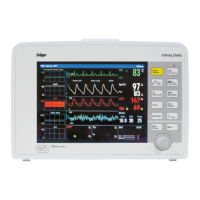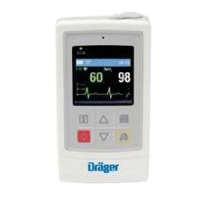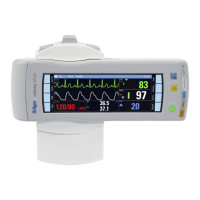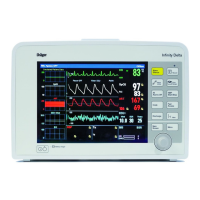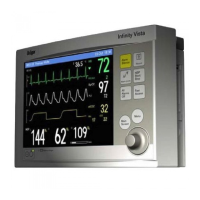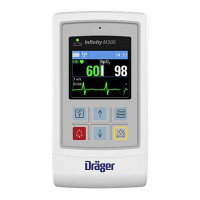1 Overview Page: 17 Reducing EMI Recommendations to minimize electromagnetic interference, including using approved accessories and managing cables.
Site of Operation Specifies environmental requirements, warnings for anesthetic mixtures, and handling of fluid spills.
Electrical Safety Guidelines for operating in clinical environments and connecting peripheral devices safely.
Device Markings Explanation of standard symbols and labels used on the device for identification and safety.
General Description Overview of the Gamma Series monitor's capabilities, portability, and monitoring functions.
Front Panel Identification and description of the monitor's front panel components.
Back Panel Identification and description of the monitor's back panel components.
Left Side Panel Identification and description of the monitor's left side panel connectors.
Right Side Panel Identification and description of the monitor's right side panel components.
Alarm Colors Explanation of how colors are used to indicate alarm status and event importance.
Display Colors Defines the predefined colors used for displaying various parameters and waveforms.
Rotary Knob Describes how to use the rotary knob for navigating menus and changing settings.
Fixed Keys Explanation of the monitor's fixed keys and their functions for accessing monitoring features.
Menus Overview of menu access and organization for monitoring functions.
Power Sources Details on operating the monitor using battery power, AC adapter, or docking station.
MULTIMED;NEOMED Pod Information on pods used for cable management of ECG, SpO2, and temperature probes.
Recorder Information on connecting and using the Dräger R50 Series strip-chart recorder.
Remote Displays Details on connecting larger VGA video displays for enhanced monitoring views.
2 Monitor Setup Page: 49 Getting Started Initial setup steps, including battery charging and reading safety considerations.
Using the AC Adapter Instructions for connecting the AC adapter and its role in charging the battery.
Using the Battery Information on battery types, operating time, and battery gauge indicators.
Screen Brightness How to adjust the display brightness, especially for battery operation.
OR Mode Enabling and configuring the OR mode for multigas monitoring functions.
Setting Date and Time Instructions for setting the monitor's current date and time for stand-alone operation.
Standby How to place the monitor into standby mode and resume monitoring.
Saving Setups Procedure for saving current monitoring configurations for future reuse.
3 Network Applications Page: 71 Overview Describes communication links within the Infinity network for central monitoring.
Network Configurations Components of a basic Infinity network, including bedside monitors and central stations.
Basic Network Components Illustrations and identification of key network hardware like monitors, docking stations, and printers.
Basic Bedside Setups Diagrams showing common bedside configurations with IDS, CPS, and wireless components.
Network Operation How the bedside monitor operates in network mode, including docking and wireless connection.
Docking Station Description of the Infinity Docking Station (IDS) for connectivity, power, and mounting.
Central Display How the central station identifies and displays data from wireless monitors.
4 Admission;Discharge;Transfer Page: 89 Overview Explains entering/editing patient data and managing care unit/bed label assignments.
Admit Menu Steps to access the Patient Admit menu for entering patient information.
Patient Category How to select patient categories (Adult, Pediatric, Neonate) and their effect on settings.
Name and ID Instructions for entering patient name and identification details.
Admit Date Procedure for entering or editing the patient's admit date.
Patient Discharge Steps for discharging a patient, including data deletion and settings reset.
Data Transfer Methods for transferring patient data between monitors via network or memory card.
5 Alarms and Messages Page: 105 Alarm Grades Explanation of the three alarm grades: Life-threatening, Serious, and Advisory.
Life-Threatening Alarms Characteristics and causes of life-threatening alarms like asystole and ventricular fibrillation.
Serious Alarms Alerts for significant patient condition changes, such as parameter falls below alarm limits.
Advisory Alarms Lowest priority alarms resulting from technical problems or persistent artifact.
Alarm Settings Options to set alarm limits, turn parameter alarms on/off, and control alarm recordings.
Alarm Validation Feature to minimize nuisance alarms by waiting a predetermined time before triggering.
Silencing Alarms Using the Alarm Silence and All Alarms OFF keys to manage active alarms.
Alarm Silence Key How to use the Alarm Silence key to silence active alarms for one minute.
Central Alarms How the central station announces bedside alarms and remote alarm management.
Messages Explanation of different types of messages (alarm, status, diagnostic, network).
7 Recordings Page: 153 Overview Details on connecting a recorder and requesting recordings remotely.
Timed Recordings How to start a timed recording, including the data captured and cancellation methods.
Continuous Recordings Instructions for starting and cancelling continuous recordings for critical applications.
Recording Formats Description of the components and identification elements of recorded printouts.
Recording Trends How to record trend data from the tabular or graphical trend windows.
Recording Alarms Conditions under which the monitor initiates timed recordings for alarms.
Stored Recordings Information on how the monitor stores recordings and the maximum storage capacity.
Event Recall Procedure to view, print, save, or delete stored recordings.
8 ECG and Heart Rate Page: 171 Overview Describes the monitor's capabilities for displaying ECG leads and calculating heart rate.
Patient Preparation Guidelines for selecting, preparing, and placing ECG electrodes for optimal signal quality.
Cable Type How to select the number of ECG leads connected for proper detection and display.
Cascade Display Mode to display eight seconds of the same waveform by cascading the first channel to the second.
Electrosurgery (ESU) Protecting the monitor's ECG function from electrosurgery interference and burns.
Infusion pumps Managing artifact in ECG signals caused by infusion pumps.
Pacemakers Special care considerations for evaluating ECG waveforms in paced patients.
12 Pulse Oximetry Page: 227 Overview Description of pulse oximetry monitoring to determine arterial oxygen saturation and pulse rate.
Sensor Application Guidelines for selecting and applying SpO2 sensors for accurate measurements.
Cascade Display Mode to display eight seconds of the pulse waveform by cascading the first channel.
Pulse Tone Volume Adjusting the volume of the pulse tone based on arterial oxygen saturation levels.
Averaging Mode Selecting Normal or Fast averaging mode for SpO2 and pulse rate calculation.
13 End-Tidal CO2 Page: 239 Overview Describes monitoring end-tidal CO2 (etCO2) using the etCO2 pod or Scio module.
etCO2 Source Selecting the CO2 signal source as either the etCO2 pod or Scio module.
etCO2 Display Explanation of the etCO2 parameter box, parameters displayed, and normal waveform phases.
Sidestream Monitoring Setup instructions for sidestream monitoring, appropriate for non-intubated patients.
Sensor Calibration Steps for calibrating the Capnostat sensor, including zeroing and verification.
Averaging Mode Setting the averaging interval for etCO2 measurement (Instantaneous, Breath, 10s, 20s).
RRc Apnea Time Setting the RRc apnea time for detecting apnea conditions.
Balance Setting the airway gas balance (Air, N2O/O2, >60% O2, Heliox) for etCO2 measurements.
Measuring Mode Configuring the etCO2 pod for mainstream or sidestream monitoring.
etCO2 Alarms Overview of etCO2 parameters that trigger alarms and their setting ranges.
14 Multigas Page: 259 Overview Information on multigas monitoring availability and supported agents.
Connections Details on connecting the Scio module to the monitor or docking station.
Gamma XL with Scio Specific connection instructions for the Gamma XL monitor with the Scio module.
Networked Monitor Connection diagram for a networked setup with the Scio module and IDS.
The Scio Module Description of the Scio module's function, sampling process, and cautions.
Warm-Up Information about the Scio module's initialization and warm-up period for accuracy.
Site of Operation Guidelines for selecting an appropriate site of operation for the Scio module.
OR Mode Enabling and configuring the OR mode for multigas monitoring on Gamma XL.
Agent Override Selecting a specific agent for display, overriding automatic detection.
Multigas Alarms Setting upper and lower multigas alarm limits on the Alarm Limits table.
Autozero Delay Requesting a delay for the Scio module's automatic zeroing process.
A Options and Accessories Page: 299 Options List of available software options and their order numbers for the Infinity Gamma Series.
ECG Overview of ECG accessories, including ESU blocks and lead sets.
ESU Block Specific ECG accessory for use during electrosurgery.
ECG Leads Color coding schemes and part numbers for ECG grabber sets.
Miscellaneous ECG Other ECG accessories such as electrodes, adhesive rings, and adapter pins.
Disposable Sensors Catalog of disposable SpO2 sensors for different patient types and weight ranges.
Multigas Consumables and accessories for the Scio Multigas module.
Cables Connection cables for the Scio module.
Temperature Temperature probes and adapter cables for the monitor.
Skin Probes Reusable skin temperature probes for axillary use.
Reusable Cuffs Available sizes and part numbers for reusable NBP cuffs.
Power Sources AC power adapters, battery chargers, and replacement batteries.
Power Cords Power cords for different regions and docking station power supplies.
Options Interface plates, docking stations, and mounting devices for system configuration.
Recorder List of R50 Series recorders, cables, and paper.
Mounting Devices Various mounting solutions for monitors, docking stations, and displays.
D Technical Data Page: 345 Overview Contains technical specifications for the monitor and its accessories.
etCO2 Pod Specifications for the etCO2 pod, including size, weight, connections, and environmental requirements.
Scio Multigas Module Specifications for the Scio Multigas Module, including size, weight, power, and environmental requirements.
R50 N Network Recorder Specifications for the R50 Network Recorder, including dimensions, power, and environmental requirements.
Monitoring Specifications Detailed technical specifications for ECG, Arrhythmia, ST Analysis, Respiration, etCO2, Pulse Oximetry, Temperature, NBP, and IBP.
ECG Specifications for ECG monitoring, including accessories, parameters, sweep speed, and accuracy.
Arrhythmia Measurement range, display resolution, accuracy, and response time for arrhythmia detection.
ST Segment Analysis Specifications for ST segment analysis, including measurement range, accuracy, and response time.
Respiration Specifications for respiration monitoring, including method, electrodes, and measurement range.
etCO2 Specifications for etCO2 monitoring, including parameter display, measuring methods, and accuracy.
Pulse Oximetry (SpO2) Specifications for SpO2 monitoring, including measuring range, accuracy, and alarms.
Temperature Specifications for temperature monitoring, including input connector, range, and accuracy.
